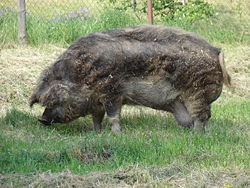 100 years ago, a Hungarian breed of pig called Mangalitsa was the preferred pork breed for restaurants across Europe and the eastern U.S. Over the last century their popularity declined for a variety a reasons. The Mangalitsa also fell out of favor with pork producers, because they require open pasture and high quality feed, as opposed to common breeds today, which can be raised in small pens on an industrial scale on cheap feed like corn or soy.
100 years ago, a Hungarian breed of pig called Mangalitsa was the preferred pork breed for restaurants across Europe and the eastern U.S. Over the last century their popularity declined for a variety a reasons. The Mangalitsa also fell out of favor with pork producers, because they require open pasture and high quality feed, as opposed to common breeds today, which can be raised in small pens on an industrial scale on cheap feed like corn or soy.
However, recently, the Mangalitsa has returned as a favorite in some chefs kitchens, because, unlike most popular breeds, Mangalitsa pork is marbled. This gives the meat a rich, authentic taste that makes it unique among pigs. This is good news for the Mangalitsa, because just a few years ago the breed was bordering on extinction, with numbers in the hundreds, as opposed to 30,000 individuals in 1950 in Hungary alone.
At least one farm has imported the Hungarian pig to the U.S., and Mangalitsa pork, previously only available from Spain, has begun to spread to other Western countries. Restaurants like the Spotted Pig in New York city have begun serving the pork with much success. Mangalitsa meat fetches a much heftier price than industrial pork, but for customers who value taste over price, the succulent marbled meat of Hungarian pork can be a satisfying experience.
 Corner Booth Blog | TundraFMP Restaurant Supply, News & Equipment Blog
Corner Booth Blog | TundraFMP Restaurant Supply, News & Equipment Blog




I’d like to correct some inaccuracies.
100 years ago, there wasn’t any Mangalitsa in the USA. There’s only been Mangalitsa in the USA since 2007. The USA had its own breed (more info at http://woolypigs.blogspot.com/2008/11/transformation-of-poland-china.html ) like the Mangalitsa 100 years ago – but there weren’t any Mangalitsa in the western hemisphere until I imported them.
Also, the Mangalitsa was one of Hungary’s first industrially raised breeds. Traditionally (from 1833 to now), it has been raised on farms. People fed the pigs excess food to produce very fat pigs, used for lard. You can also run them in the forest (and people did this) – but that’s not why the breed became so popular and numerous. The breed became so popular and numerous because it was possible to raise them on farms, and there was excess food (from farming) to feed the pigs. More info here:
http://woolypigs.blogspot.com/2009/04/lard-type-hog-production-in-hungary-and.html
http://woolypigs.blogspot.com/2009/05/smithfield-in-romania.html
Thanks for the info Heath! A couple clarifications: note that I didn’t say that Mangalitsa pigs themselves were in the U.S. 100 years ago, only that Mangalitsa pork was available in restaurants. Also, your point about raising the Mangalitsa on farms is true, but it is also true that the Mangalitsa requires much more room and better feed than modern industrial pork breeds.